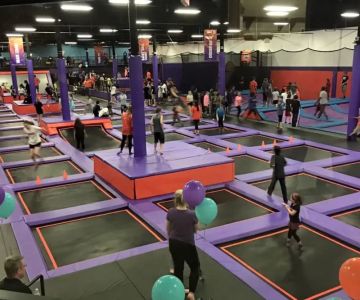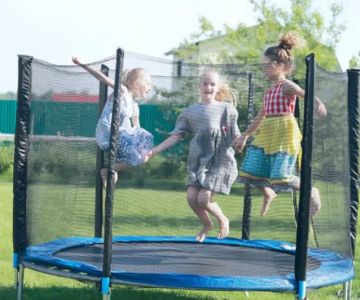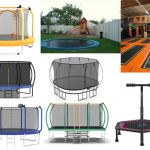- 1-Key-Differences-Between-Indoor-and-Outdoor-Trampolines
- 2-Advantages-of-Indoor-Trampolines
- 3-Advantages-of-Outdoor-Trampolines
- 4-Considerations-for-Safety-and-Maintenance
- 5-Real-Life-Experiences-and-User-Preferences
- 6-Choosing-the-Right-Trampoline-with-Trampoline-Zone
1. Key Differences Between Indoor and Outdoor Trampolines
When comparing indoor vs. outdoor trampolines, several fundamental differences come into play, including size, durability, space requirements, and usage. Indoor trampolines are generally smaller, designed for compact spaces and easier supervision. Outdoor trampolines tend to be larger, often with safety enclosures, and built to withstand weather conditions.
Understanding these differences is essential for selecting a trampoline that fits your home environment, lifestyle, and safety needs.
2. Advantages of Indoor Trampolines
Indoor trampolines offer the convenience of year-round use, unaffected by weather conditions like rain or extreme heat. They are ideal for small spaces such as playrooms or basements and provide a controlled environment for younger children. The compact size often means easier setup and portability.
Additionally, indoor trampolines can be a great solution for parents seeking to keep kids active indoors during winter months or urban living situations where outdoor space is limited.
3. Advantages of Outdoor Trampolines
Outdoor trampolines bring the excitement of larger bounce areas, often with enhanced safety features like padded edges and netted enclosures. They provide a perfect way to enjoy fresh air and sunlight while engaging in active play. Their durability against weather elements makes them a long-term investment for families with ample backyard space.
Outdoor trampolines also encourage social activities, accommodating multiple children and promoting outdoor gatherings, which can enhance physical fitness and social skills.
4. Considerations for Safety and Maintenance
Safety is a top priority when choosing between indoor and outdoor trampolines. Indoor models require soft flooring nearby and close supervision to prevent injuries in confined spaces. Outdoor trampolines must be regularly checked for weather-related wear and secured properly to avoid accidents.
Maintenance differs as well: outdoor trampolines need weatherproof covers and periodic cleaning, while indoor trampolines benefit from routine inspections and clear surrounding space. Knowing these factors helps ensure a safe and enjoyable trampoline experience.
5. Real-Life Experiences and User Preferences
Many families share their experiences to highlight the practical aspects of both trampoline types. One urban parent praised indoor trampolines for keeping their children entertained during winter, while a suburban family valued their outdoor trampoline for weekend fun and social playdates.
These real-life stories illustrate how personal circumstances and priorities influence the choice, emphasizing that neither option is universally better but depends on individual needs.
6. Choosing the Right Trampoline with Trampoline Zone
When deciding between indoor vs. outdoor trampolines, consulting experts and exploring quality options is vital. Trampoline Zone offers a wide selection of trampolines tailored to diverse needs, with detailed product descriptions and safety features clearly outlined.
Whether you need a compact indoor trampoline or a robust outdoor model, Trampoline Zone provides reliable products and professional advice to help you make an informed decision. Their trusted service ensures you get the perfect trampoline for your family’s fun and fitness.







 The Trampoline Group4.0 (3 reviews)
The Trampoline Group4.0 (3 reviews) The Jump Yard4.0 (75 reviews)
The Jump Yard4.0 (75 reviews) Urban Air Trampoline and Adventure Park4.0 (935 reviews)
Urban Air Trampoline and Adventure Park4.0 (935 reviews) J's Escape4.0 (73 reviews)
J's Escape4.0 (73 reviews) Intents Inflatables Indoor Fun Center4.0 (267 reviews)
Intents Inflatables Indoor Fun Center4.0 (267 reviews) The Fun & Fit Factory, LLC4.0 (44 reviews)
The Fun & Fit Factory, LLC4.0 (44 reviews) Are Trampoline Parks Safe for Kids? Essential Guide for U.S. Parents
Are Trampoline Parks Safe for Kids? Essential Guide for U.S. Parents How Often Should You Replace Trampoline Springs? Tips for Proper Maintenance
How Often Should You Replace Trampoline Springs? Tips for Proper Maintenance How Much Is a Trampoline? A Detailed Guide to Trampoline Costs and Buying Tips
How Much Is a Trampoline? A Detailed Guide to Trampoline Costs and Buying Tips Bounce Techniques for Stronger Legs: Effective Exercises and Tips
Bounce Techniques for Stronger Legs: Effective Exercises and Tips Essential Music Gear for Trampoline Dance: Complete Guide
Essential Music Gear for Trampoline Dance: Complete Guide Fun STEM Experiments Using Trampolines to Spark Curiosity and Learning
Fun STEM Experiments Using Trampolines to Spark Curiosity and Learning